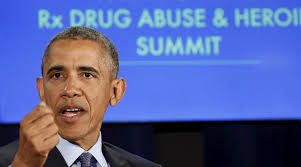“I am a very strong believer that the path we have taken in the United States in the so-called war on drugs has been so heavy in emphasizing incarceration that it has been counterproductive. You have young people who did not engage in violence who get very long penalties, who get placed in prison and then are rendered economically unemployable, are almost pushed into the underground economy, learn crime more effectively in prison — families are devastated. So it’s been very unproductive.”- Barack Obama; 2015
 It is the longest war in the history of the world, and so it continues. President after president, administration after administration have adopted a plethora of policies and strategies to curb the increasing epidemic of drug abuse, addiction and death in the United States. Some could say these efforts have been futile, with the problem growing year on year. As the Obama Administration is coming to it’s conclusion, can it affect real change in this so-called war? For those who believe that the approach to this issue has been wrong all these years, President Obama has changed the course of action being taken and paved the way to decriminalization of drug use, seeking to treat it as a serious public health issue.
It is the longest war in the history of the world, and so it continues. President after president, administration after administration have adopted a plethora of policies and strategies to curb the increasing epidemic of drug abuse, addiction and death in the United States. Some could say these efforts have been futile, with the problem growing year on year. As the Obama Administration is coming to it’s conclusion, can it affect real change in this so-called war? For those who believe that the approach to this issue has been wrong all these years, President Obama has changed the course of action being taken and paved the way to decriminalization of drug use, seeking to treat it as a serious public health issue.
The national plan for the administration’s drug policy was released in 2010. With just six months left can Obama conquer the epidemic, or at the very least leave a solid for foundation from which the battle can be fought. The premise of the National Drug Control Strategy is that reform in drug policy is essential in order to make gains and it should be rooted in scientific, evidence based prevention programs, increased access to treatment as well as an emphasis on recovery and finally criminal justice reform.
There is no doubt that a new approach is required and this strategy presents as the best option. The costs to our country economically and socially is and has been significant. In 2007, illicit drug use cost the US over €193 billion through loss of productivity, healthcare and criminal justice costs. There is a specific focus on opioid abuse and addiction, with a recognition of the huge impact prescription medication is having on America’s drug addiction problem. The White House sees the issue very clearly through stats provided by the Centre for Disease Control which show that opioids have killed 28,647 people in 2014, a four-fold increase in opioid overdoses since 2000. A problem of this magnitude requires careful and pertinent consideration and the Obama Administration’s strategy has been referred to as the 21st Century approach to drug policy. The national plan with a pragmatic approach, rooted in science and evidence outlines over 100 specific reforms in order to address the issue, protecting public health and safety in America.
The National Drug Abuse and Heroin Summit took place in March of this year and president Obama made very clear
his approach to the drugs issue. He reiterated what has been clear since the inaugural strategy of 2010 that they support prevention and treatment options as opposed to criminilization. The most significant investment in this plan is $94 in “new funding”, as well as $116 million specifically for treatment, a further $7 for the justice system in order to increase community policing. To hear Obama at the Summit, to review the Strategy and to consider the vastness of investment in this new approach you can’t help but feel optimistic. The war on drugs has failed miserably to date and in all instances it has been proven that prevention is better than cure.
The cost to the criminal justice system is staggering and a move from this method to an emphasis on prevention will alleviate this burden on our finances and our prison system. The strategy deems this the most cost effective way in reducing use and thus the consequences; this requires education, starting with young people. Research indicates that every dollar invested into school based substance use prevention programs can potentially save $18 is the costs related to substance use disorders. While recovery is a complex process and many failed attempts are synonymous with one’s journey, there are millions who have overcome their addiction only to be faced with barriers to their sobriety and life in general, these include housing, employment, loans and credit. The Administration intends to eliminate the legislation and regulations that create these barriers to Americans as well as the establishment of a Recovery Branch to support people during their recovery and to tackle the stigma associated with addiction. Obama’s recent announcements also show an increase in the level of intervention in the private sector. Initiatives in the private sector include one working with over 60 medical schools ensuring that students study recent guidelines from the Centre for Disease Control regards the prescription of opioids. These preventative and intervention measures backed by significant investment see an opportunity to change the face of the drugs problem in the America for good. But are some of these measures just patching over the cracks,as opposed to taking head on the possible root of the issue.
The drugs business is the third biggest in the world after oil and arms, with a value of £198 billion per year according to research undertaken by the United Nations. With an industry this lucrative and mega bucks to be made, can drugs really be eradicated from society? Policy attacks supply head on every time, if equal consideration was given to the reasons for demand we may be a little further along. Many of Drug Rehab Comparison’s pieces have looked at the war on drugs, its successes and failures. Specifically we looked at Vermont’s war on drugs and the stance of Governor Schumlin. He apologetically highlighted a huge contributing factor to the drugs issue, laying the blame clearly at the feet of poor regulation and legislation from the Food and Drugs Administration, in favour of big pharma. Has the Obama Administration been this clear?
Are millions of dollars of investment in re education, training, intervention and preventative measures in vain if addictive prescription medications continue to be allowed on the market, and are advertised and promoted like every day popular produce. This is the only country where prescription medication is publicly advertised, in all other countries around the world prescription meds are only advertised to those in the medical profession. Without a genuine allegiance with the people of the United States, with their health and well being the priority, will anything really change? In a profit driven system, facilitated by politicians, are the millions being invested to address the drugs problem being wasted. Obama’s commitment to truly overcoming this epidemic came into question just a month after his address at the National Drugs Summit. When he appointed Dr. Robert Califf as the new commissioner for the Food and Drugs Administration. Much of the new commissioner’s career has been funded by big pharma companies, a worrying pick from Obama considering what looks like an already very cosy relationship. In spite of all the positive steps taken, if Obama cannot say no to the big corporations, has he really got what it takes to conquer America’s drugs problem?
Sources:
https://www.theguardian.com/us-news/2016/mar/29/obama-administration-opioid-heroin-funds
https://www.whitehouse.gov/ondcp/drugpolicyreform
http://drugsafetynews.com/2016/04/20/obamas-pick-head-fda-worst-selection-ever/


